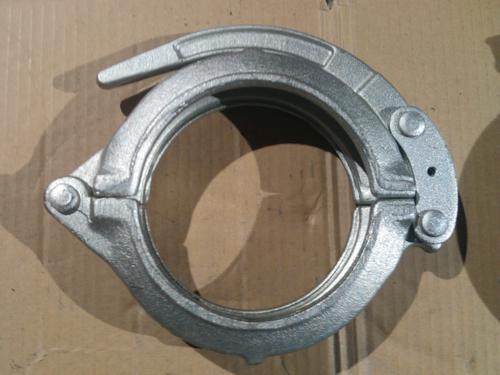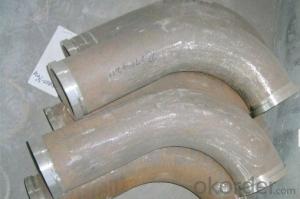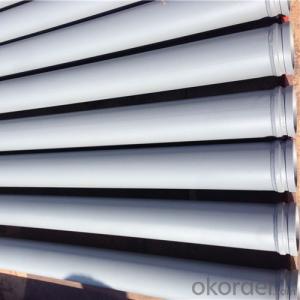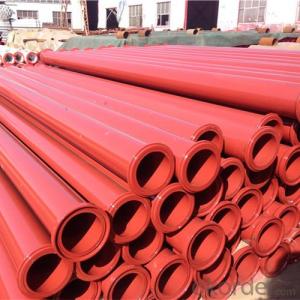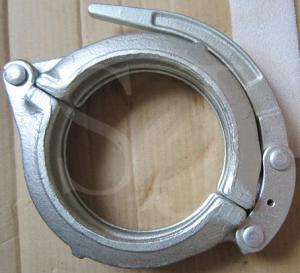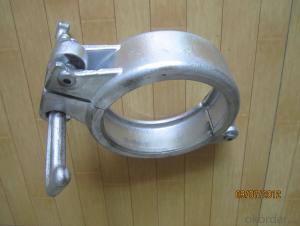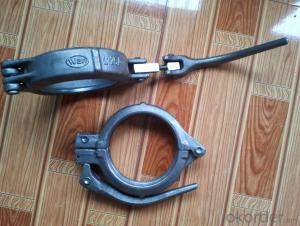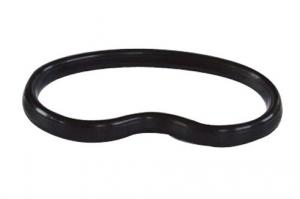High Quality Forged Snap Coupling DN125
- Loading Port:
- Tianjin
- Payment Terms:
- TT or LC
- Min Order Qty:
- 5 pc
- Supply Capability:
- 10000 pc/month
OKorder Service Pledge
OKorder Financial Service
You Might Also Like
Product Description:
Name:High Quality Forged Snap Coupling DN125
Type: Snap coupling, Bolt coupling, Wedge Coupling, adjustable or mounting type
Dimensions: DN125, 5"
Process: Casting or Forging.
Surface treatment: Painted or Galvanized.
Notes: total series of concrete pump clamp for different brand concrete pump(PUTZMEISTER, SCHWING, CIFA, SANY, ZOOMLION, IHI, KYOKUTO Etc) available from us, such as Snap coupling, Bolt coupling, Wedge Coupling, adjustable or mounting type .
Scope of Application of the Equipment
Forged Snap Coupling DN125 widely used on concrete pump truck, concrete placing boom, trailer concrete pump etc, for concrete delivery pipe connection.
Our concrete pump clamps have been successfully exported to many countries from 1998, Our main markets as below: Middle East, Southeast Asia, America, Brazil, Italy, Russia, South Africa etc
Aiming at the largest concrete pump parts manufacturer, and reliable, professional supplier in China, we can supply concrete pump elbows, delivery pipes, casting or forging couplings, end rubber hoses, rubber pistons, tungsten wear plates, delivery cylinders, and other hydraulic parts, one stop service for your concrete pump parts and accessory business.
Product Advantages:
Forged Snap Coupling DN125 are durable, strong, and resists corrosion.
Main Product Features:
· Premium quality
· Prompt delivery & seaworthy packing (10-20 days after receiving deposit)
Reliable performance
Easy and smooth operation
High safety.
· Professional Service
· Competitive pricing
Product Specifications:
Every 300pcs put in one seaworthy wooden box, and 20 boxes in one 20feet container.
FAQ:
Q1: Why buy Materials & Equipment from us?
A1: All products are through its ISO certifications, adhere to the highest standards and a commitment to supply chain safety and customer satisfaction.
Q2: How do we guarantee the quality of our products?
A2: We have established an advanced quality management system which conducts strict quality tests at every step, from raw materials to the final product. At the same time, we provide extensive follow-up service assurances as required.
Q3: How soon can we receive the product after purchase?
A3: Within three days of placing an order, we will begin production. The specific shipping date is dependent upon international and government factors, but is typically 10 to 30 workdays.
Q4: If we can produce some Forged Snap Coupling DN125 according to customers request?
A4: Yes, we can produce Forged Snap Coupling DN125 according to the difference country situations and different concrete pump to make it suitable to the market and customers. We have very professional technical team to make the design.
Q5: How to make a quick resolution for after service?
A5:We have overseas branches all-around of world, IF needed, the seller shall dispatch 2 engineers to the buyer's site for supervision of training. The buyer shall make available of necessary facilities &skilled personnel at site for training.
Images:
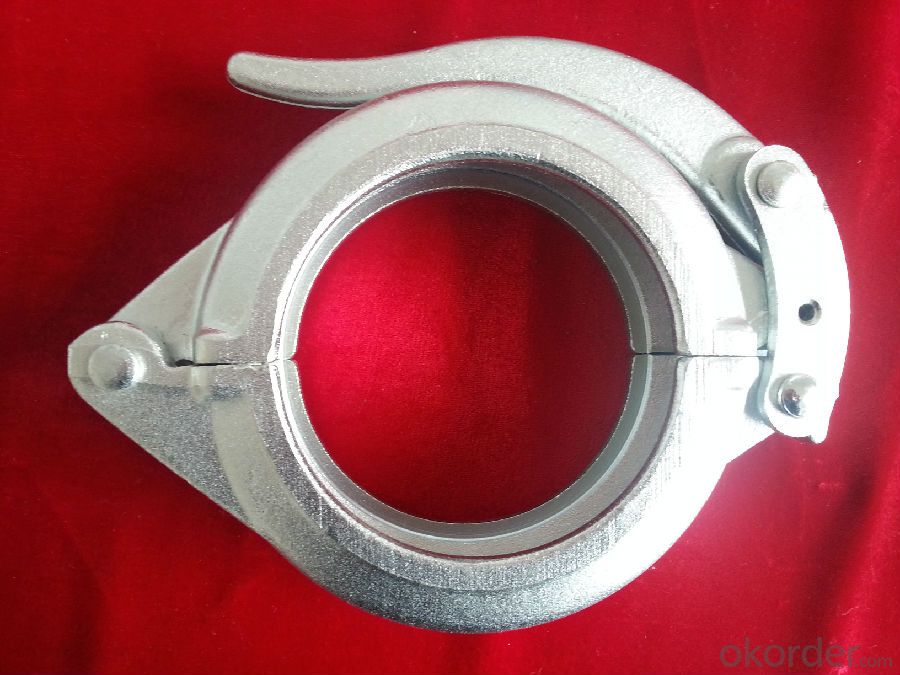

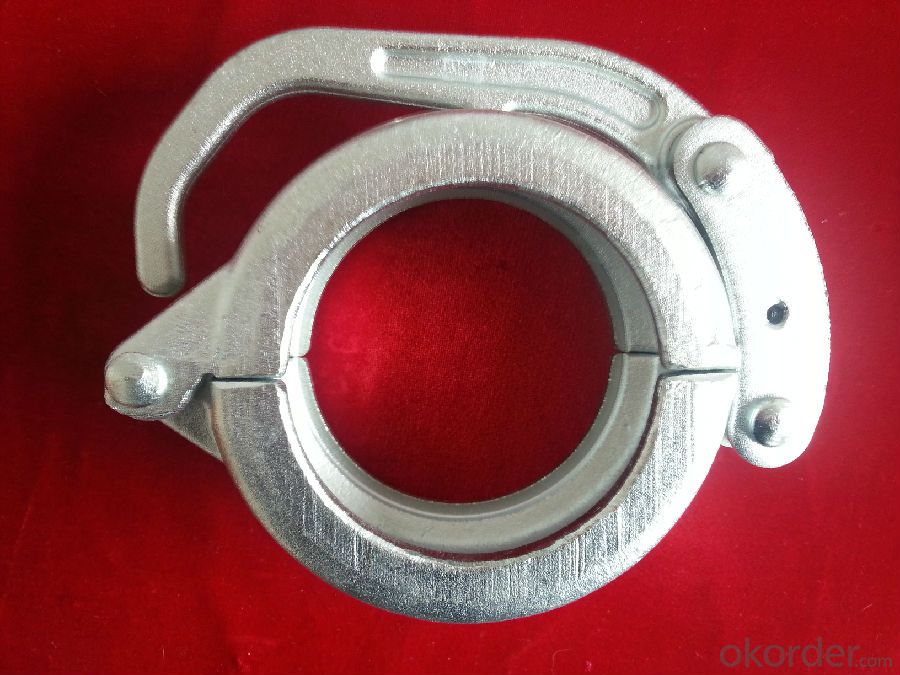
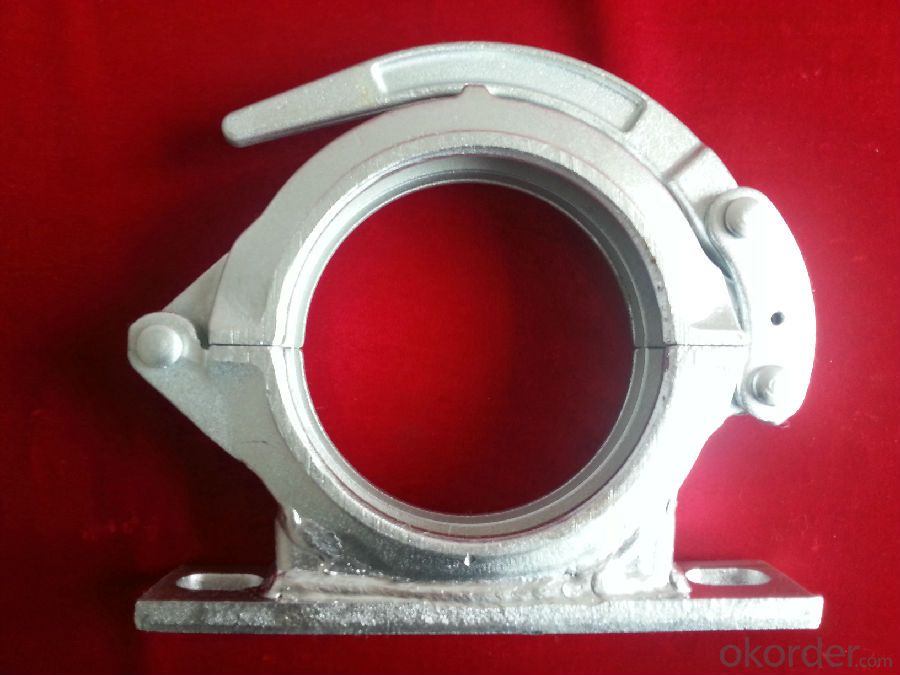
- Q: How can one ensure proper functioning of concrete pump spare parts after installation?
- To ensure proper functioning of concrete pump spare parts after installation, it is important to follow a few key steps. Firstly, it is crucial to carefully inspect and clean the parts before installation to ensure they are free from any debris or damage. Additionally, it is essential to use high-quality parts from reputable manufacturers to ensure durability and reliability. Regular maintenance and lubrication of the spare parts is also necessary to prevent wear and tear. Lastly, it is important to operate the concrete pump within its specified limits and avoid overloading, as this can cause stress on the spare parts and lead to malfunctioning.
- Q: How often should concrete pump control boxes be inspected and replaced?
- Concrete pump control boxes should be inspected regularly, ideally every 6 to 12 months, to ensure they are in good working condition. The replacement of control boxes should be done only when necessary, such as when they are damaged or malfunctioning, and should be based on the manufacturer's recommendations and industry standards.
- Q: How often should the concrete pump wear plate be replaced?
- The concrete pump wear plate should be replaced whenever it becomes significantly worn down or damaged, which typically occurs after every 20,000 to 30,000 cubic yards of concrete are pumped.
- Q: How often should a concrete pump spectacle plate be replaced?
- The frequency at which a concrete pump spectacle plate should be replaced largely depends on various factors such as the type of concrete being pumped, the intensity and duration of usage, and the overall maintenance and care given to the pump. However, as a general guideline, it is recommended to inspect and assess the condition of the spectacle plate regularly and replace it if any signs of wear, damage, or deformation are noticed. In some cases, this might be needed every few months, while in others it could be extended to a year or more. It is crucial to follow the manufacturer's recommendations and consult with industry professionals to determine the appropriate replacement schedule for the spectacle plate in order to maintain the optimal functioning and safety of the concrete pump.
- Q: What is the purpose of a concrete pump remote control battery?
- The primary function of a battery for a concrete pump remote control is to supply power and mobility to the remote control device that operates the concrete pump. By using the remote control, the operator can conveniently control the movements and functions of the concrete pump from a distance, eliminating the need to physically be at the pump location. The battery provides the required electrical energy to the remote control, enabling it to transmit wireless signals and commands to the concrete pump. This grants the operator the freedom to move around the construction site while still maintaining complete control over the concrete pump. Additionally, the battery ensures uninterrupted operation of the remote control, guaranteeing efficient and precise control over the concrete pump's functions.
- Q: What are the signs of a damaged concrete pump agitator motor?
- Indicators of a damaged concrete pump agitator motor include various signs: 1. Unusual noises: The presence of excessive grinding, rattling, or squeaking noises emanating from the agitator motor may suggest damage. These noises could possibly indicate the need for attention to worn-out bearings or other internal components. 2. Inconsistent operation: If irregular or inconsistent mixing of the concrete occurs, it could be a sign of a damaged agitator motor. Whether the concrete is not being mixed properly or the agitation speed is inconsistent, it is possible that the motor is damaged. 3. Overheating: To identify a problem, the agitator motor becoming excessively hot during operation may serve as a clue. Overheating can be the result of various issues, such as a faulty motor or insufficient lubrication. In such cases, it is crucial to promptly address the issue to prevent further damage and potential breakdown. 4. Vibrations: The occurrence of excessive vibrations during operation could indicate a damaged motor. Vibrations may arise from imbalanced or misaligned components within the motor, leading to reduced efficiency and increased wear and tear. 5. Electrical issues: If the motor experiences electrical problems, such as tripping circuit breakers or blowing fuses, it might suggest a damaged motor. These issues can result from faulty wiring, short circuits, or damaged electrical components, requiring the attention of a professional. 6. Reduced performance: A damaged agitator motor can cause reduced performance or decreased efficiency. If the agitator is not working as effectively as before, or if the concrete is not being mixed thoroughly, it could be a sign of motor damage. In case of suspicion regarding the damage of the concrete pump agitator motor, it is advisable to seek assistance from a professional technician or service provider with expertise in concrete pump machinery. They can accurately diagnose the issue and provide suitable solutions for repairing or replacing the damaged motor.
- Q: How can one determine the correct voltage and current rating for electrical components in concrete pump spare parts?
- To determine the correct voltage and current rating for electrical components in concrete pump spare parts, several factors need to be considered. Firstly, it is essential to consult the manufacturer's specifications and documentation for the concrete pump and its spare parts. These documents usually provide detailed information about the voltage and current requirements for each electrical component. Paying close attention to these guidelines ensures that the components are operated within their designed parameters. Secondly, it is crucial to understand the electrical system and its requirements. This involves analyzing the power supply available at the site where the concrete pump will be used. Factors such as the voltage level (e.g., 110V, 220V, 440V) and frequency (e.g., 50Hz, 60Hz) of the electrical supply need to be taken into account. Additionally, the maximum current capacity of the electrical system must be considered to prevent overload situations. Furthermore, it is advisable to assess the specific application and operating conditions of the concrete pump. Different components may have varying voltage and current requirements depending on their function and the environment in which they are used. For instance, components installed in outdoor areas may require higher voltage ratings to withstand harsh weather conditions. Lastly, seeking professional assistance from qualified electricians or engineers is highly recommended. They possess the expertise and knowledge to accurately determine the voltage and current ratings for electrical components in concrete pump spare parts. Their experience allows them to consider various factors such as safety regulations, compatibility with the existing electrical system, and any specific requirements of the concrete pump manufacturer. By taking into account the manufacturer's specifications, understanding the electrical system, considering the application and operating conditions, and seeking professional advice, one can effectively determine the correct voltage and current rating for electrical components in concrete pump spare parts.
- Q: What are the advantages of using genuine spare parts for my concrete pump?
- There are several advantages to using genuine spare parts for your concrete pump. Firstly, genuine parts are specifically designed and manufactured to fit and function perfectly with your pump, ensuring optimal performance and reliability. These parts are made with high-quality materials and undergo rigorous testing, providing durability and longevity. Secondly, using genuine spare parts helps to maintain the integrity and efficiency of your concrete pump. Non-genuine parts may not meet the same standards, leading to decreased performance, increased downtime, and potentially costly repairs. Genuine parts also come with warranties, providing peace of mind and assurance of their quality. Moreover, using genuine spare parts ensures compatibility with the rest of your equipment and reduces the risk of damage or malfunction. Mixing non-genuine parts with genuine ones can lead to mechanical issues, which can be avoided by sticking to genuine replacements. Lastly, using genuine spare parts helps to retain the value of your concrete pump. When it comes to selling or trading in your equipment, having genuine parts installed increases its market value, as it indicates that the pump has been properly maintained and cared for. Overall, investing in genuine spare parts for your concrete pump guarantees superior performance, longevity, compatibility, and value, making it a wise and cost-effective choice in the long run.
- Q: What are the common causes of overheating in concrete pump spare parts?
- The common causes of overheating in concrete pump spare parts can be attributed to factors such as high ambient temperatures, inadequate lubrication, excessive load or pressure, worn-out or damaged components, and insufficient cooling systems.
- Q: How can a malfunctioning control panel affect the pump's operation?
- A malfunctioning control panel can affect the pump's operation by causing errors in controlling the pump's speed, pressure, or flow rate. It can also lead to inaccurate monitoring of the pump's performance, failure to detect faults or abnormalities, and difficulty in troubleshooting issues. Ultimately, a malfunctioning control panel can compromise the pump's efficiency, reliability, and overall functionality.
Send your message to us
High Quality Forged Snap Coupling DN125
- Loading Port:
- Tianjin
- Payment Terms:
- TT or LC
- Min Order Qty:
- 5 pc
- Supply Capability:
- 10000 pc/month
OKorder Service Pledge
OKorder Financial Service
Similar products
Hot products
Hot Searches
Related keywords



